Optimizing Canal System Design for Effective Flood Prevention
VerifiedAdded on 2023/06/05
|10
|2122
|84
AI Summary
In this research we will discuss about canal system design for flood prevention and below are the summaries point:-
Research topic: Optimizing Canal System Design for Flood Prevention at Angono National High School
Research problem: Inadequate canal system leading to flooding during rainy seasons at the school.
Research questions: Relationship between rainfall and canal size, maximum flow rate, slope angle, construction materials, optimal design, and topographical influence.
Contribute Materials
Your contribution can guide someone’s learning journey. Share your
documents today.
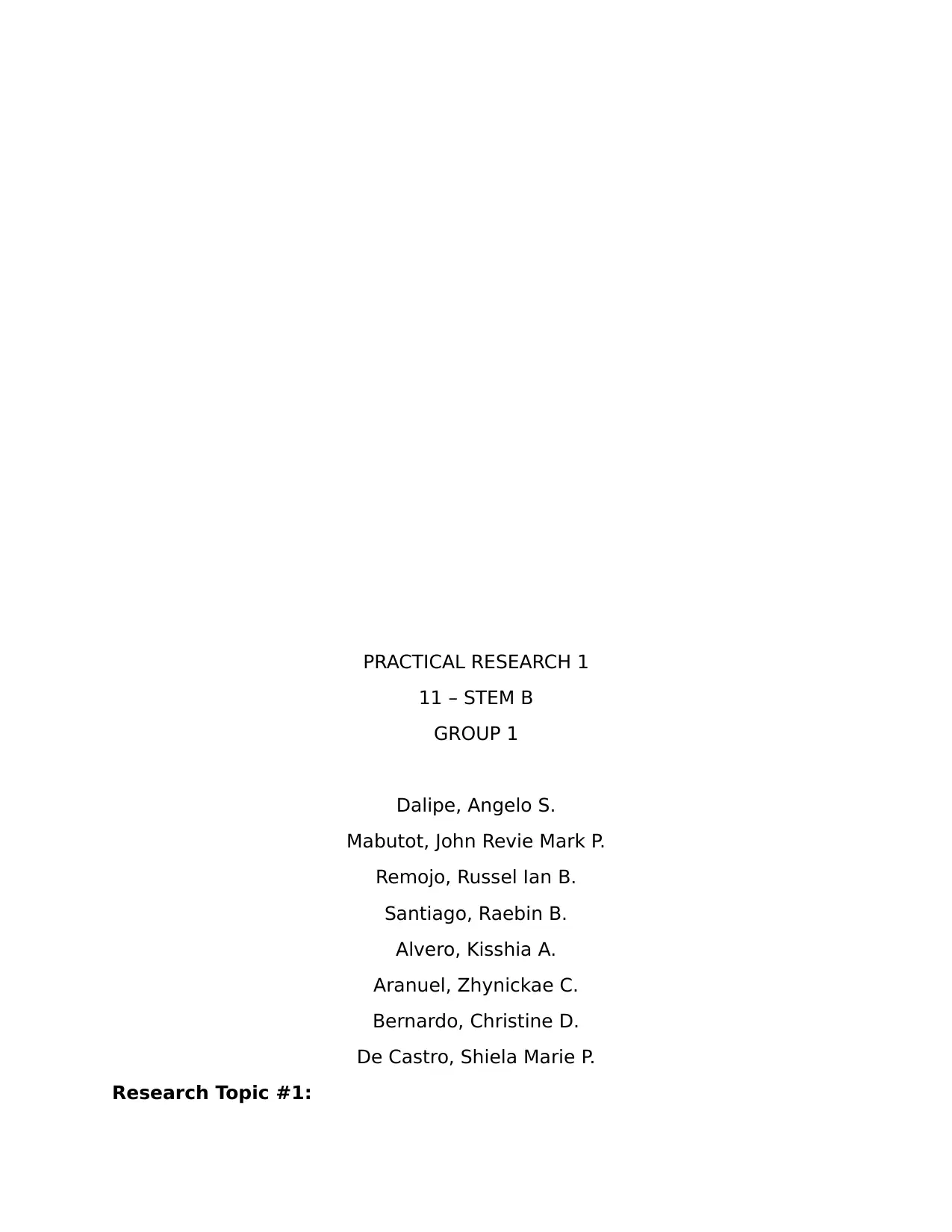
PRACTICAL RESEARCH 1
11 – STEM B
GROUP 1
Dalipe, Angelo S.
Mabutot, John Revie Mark P.
Remojo, Russel Ian B.
Santiago, Raebin B.
Alvero, Kisshia A.
Aranuel, Zhynickae C.
Bernardo, Christine D.
De Castro, Shiela Marie P.
Research Topic #1:
11 – STEM B
GROUP 1
Dalipe, Angelo S.
Mabutot, John Revie Mark P.
Remojo, Russel Ian B.
Santiago, Raebin B.
Alvero, Kisshia A.
Aranuel, Zhynickae C.
Bernardo, Christine D.
De Castro, Shiela Marie P.
Research Topic #1:
Secure Best Marks with AI Grader
Need help grading? Try our AI Grader for instant feedback on your assignments.
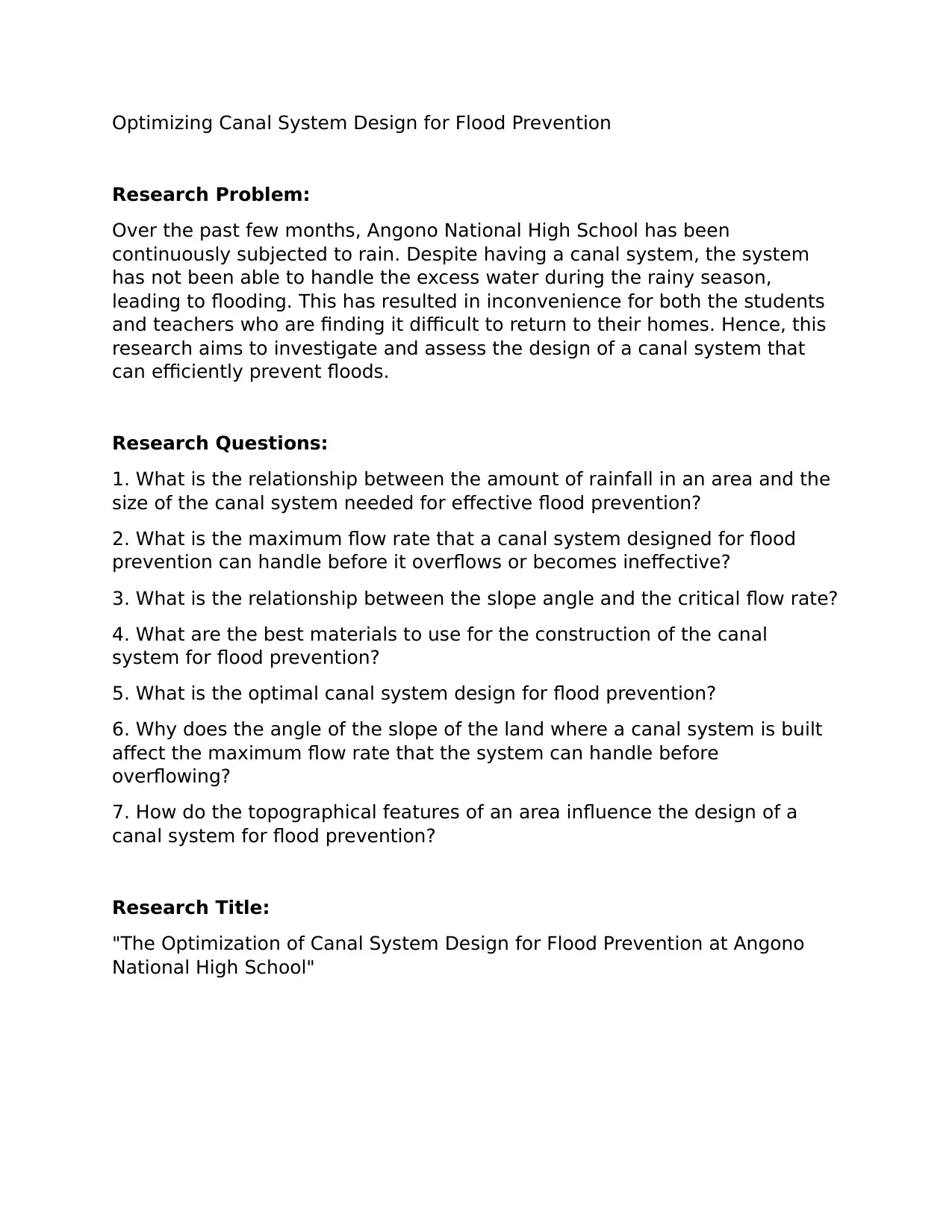
Optimizing Canal System Design for Flood Prevention
Research Problem:
Over the past few months, Angono National High School has been
continuously subjected to rain. Despite having a canal system, the system
has not been able to handle the excess water during the rainy season,
leading to flooding. This has resulted in inconvenience for both the students
and teachers who are finding it difficult to return to their homes. Hence, this
research aims to investigate and assess the design of a canal system that
can efficiently prevent floods.
Research Questions:
1. What is the relationship between the amount of rainfall in an area and the
size of the canal system needed for effective flood prevention?
2. What is the maximum flow rate that a canal system designed for flood
prevention can handle before it overflows or becomes ineffective?
3. What is the relationship between the slope angle and the critical flow rate?
4. What are the best materials to use for the construction of the canal
system for flood prevention?
5. What is the optimal canal system design for flood prevention?
6. Why does the angle of the slope of the land where a canal system is built
affect the maximum flow rate that the system can handle before
overflowing?
7. How do the topographical features of an area influence the design of a
canal system for flood prevention?
Research Title:
"The Optimization of Canal System Design for Flood Prevention at Angono
National High School"
Research Problem:
Over the past few months, Angono National High School has been
continuously subjected to rain. Despite having a canal system, the system
has not been able to handle the excess water during the rainy season,
leading to flooding. This has resulted in inconvenience for both the students
and teachers who are finding it difficult to return to their homes. Hence, this
research aims to investigate and assess the design of a canal system that
can efficiently prevent floods.
Research Questions:
1. What is the relationship between the amount of rainfall in an area and the
size of the canal system needed for effective flood prevention?
2. What is the maximum flow rate that a canal system designed for flood
prevention can handle before it overflows or becomes ineffective?
3. What is the relationship between the slope angle and the critical flow rate?
4. What are the best materials to use for the construction of the canal
system for flood prevention?
5. What is the optimal canal system design for flood prevention?
6. Why does the angle of the slope of the land where a canal system is built
affect the maximum flow rate that the system can handle before
overflowing?
7. How do the topographical features of an area influence the design of a
canal system for flood prevention?
Research Title:
"The Optimization of Canal System Design for Flood Prevention at Angono
National High School"
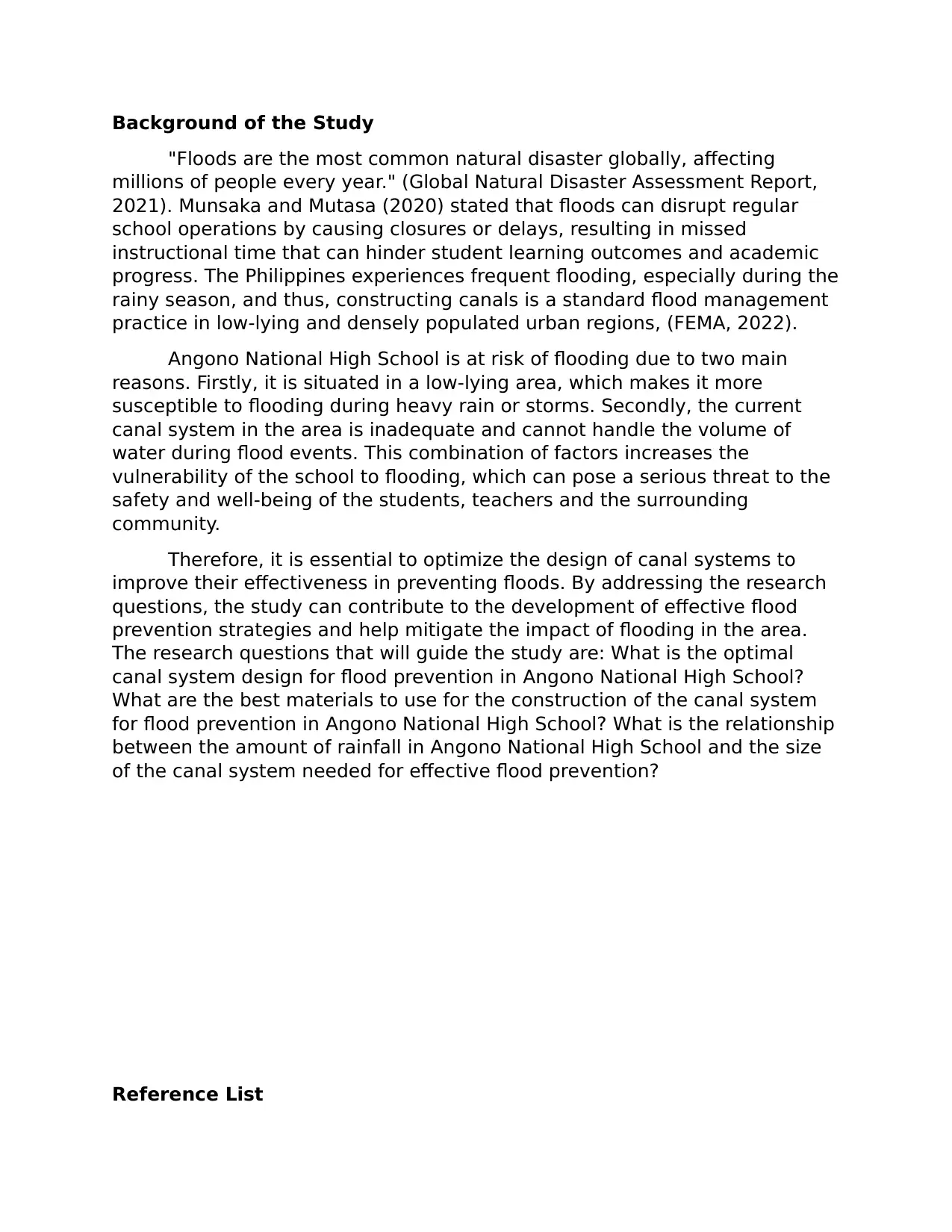
Background of the Study
"Floods are the most common natural disaster globally, affecting
millions of people every year." (Global Natural Disaster Assessment Report,
2021). Munsaka and Mutasa (2020) stated that floods can disrupt regular
school operations by causing closures or delays, resulting in missed
instructional time that can hinder student learning outcomes and academic
progress. The Philippines experiences frequent flooding, especially during the
rainy season, and thus, constructing canals is a standard flood management
practice in low-lying and densely populated urban regions, (FEMA, 2022).
Angono National High School is at risk of flooding due to two main
reasons. Firstly, it is situated in a low-lying area, which makes it more
susceptible to flooding during heavy rain or storms. Secondly, the current
canal system in the area is inadequate and cannot handle the volume of
water during flood events. This combination of factors increases the
vulnerability of the school to flooding, which can pose a serious threat to the
safety and well-being of the students, teachers and the surrounding
community.
Therefore, it is essential to optimize the design of canal systems to
improve their effectiveness in preventing floods. By addressing the research
questions, the study can contribute to the development of effective flood
prevention strategies and help mitigate the impact of flooding in the area.
The research questions that will guide the study are: What is the optimal
canal system design for flood prevention in Angono National High School?
What are the best materials to use for the construction of the canal system
for flood prevention in Angono National High School? What is the relationship
between the amount of rainfall in Angono National High School and the size
of the canal system needed for effective flood prevention?
Reference List
"Floods are the most common natural disaster globally, affecting
millions of people every year." (Global Natural Disaster Assessment Report,
2021). Munsaka and Mutasa (2020) stated that floods can disrupt regular
school operations by causing closures or delays, resulting in missed
instructional time that can hinder student learning outcomes and academic
progress. The Philippines experiences frequent flooding, especially during the
rainy season, and thus, constructing canals is a standard flood management
practice in low-lying and densely populated urban regions, (FEMA, 2022).
Angono National High School is at risk of flooding due to two main
reasons. Firstly, it is situated in a low-lying area, which makes it more
susceptible to flooding during heavy rain or storms. Secondly, the current
canal system in the area is inadequate and cannot handle the volume of
water during flood events. This combination of factors increases the
vulnerability of the school to flooding, which can pose a serious threat to the
safety and well-being of the students, teachers and the surrounding
community.
Therefore, it is essential to optimize the design of canal systems to
improve their effectiveness in preventing floods. By addressing the research
questions, the study can contribute to the development of effective flood
prevention strategies and help mitigate the impact of flooding in the area.
The research questions that will guide the study are: What is the optimal
canal system design for flood prevention in Angono National High School?
What are the best materials to use for the construction of the canal system
for flood prevention in Angono National High School? What is the relationship
between the amount of rainfall in Angono National High School and the size
of the canal system needed for effective flood prevention?
Reference List
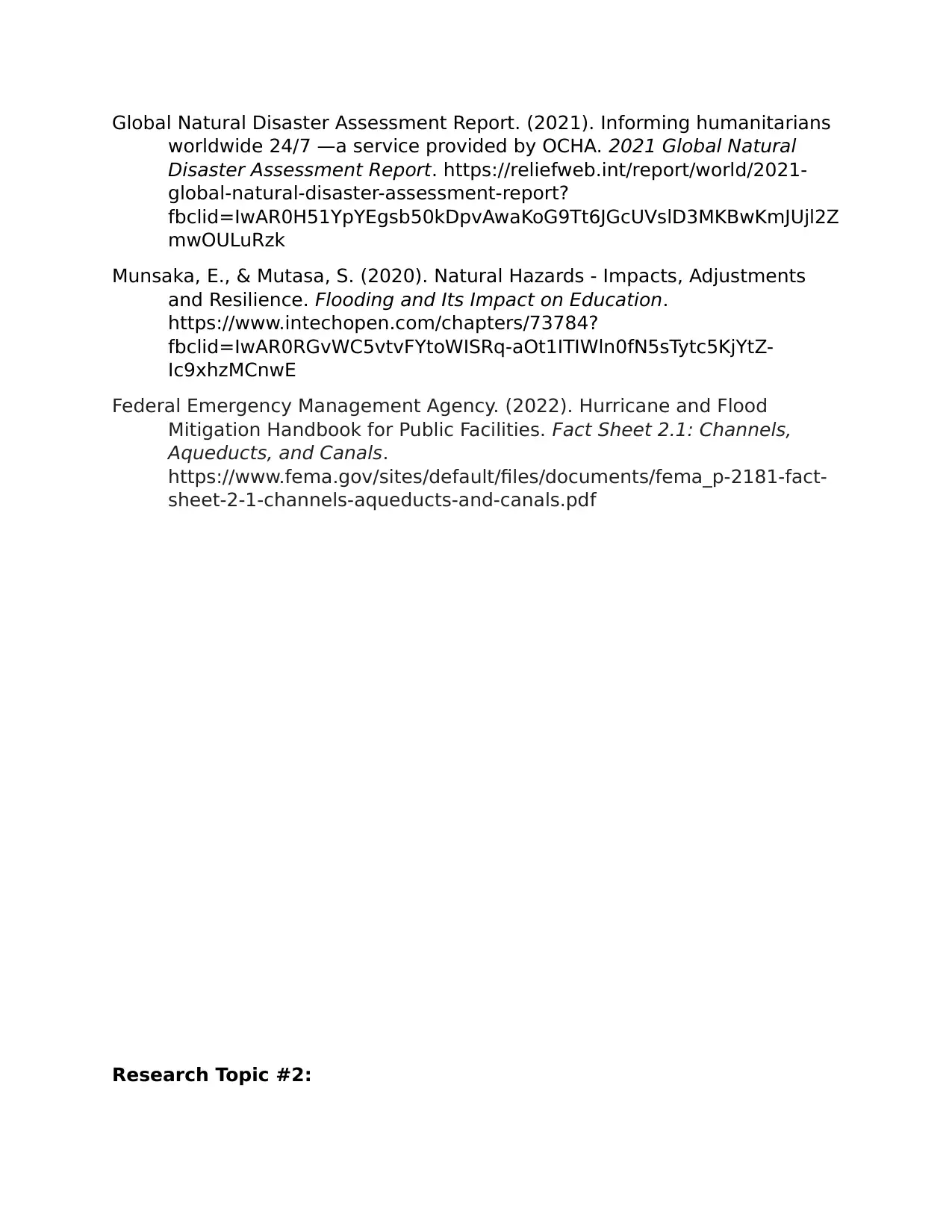
Global Natural Disaster Assessment Report. (2021). Informing humanitarians
worldwide 24/7 —a service provided by OCHA. 2021 Global Natural
Disaster Assessment Report. https://reliefweb.int/report/world/2021-
global-natural-disaster-assessment-report?
fbclid=IwAR0H51YpYEgsb50kDpvAwaKoG9Tt6JGcUVslD3MKBwKmJUjl2Z
mwOULuRzk
Munsaka, E., & Mutasa, S. (2020). Natural Hazards - Impacts, Adjustments
and Resilience. Flooding and Its Impact on Education.
https://www.intechopen.com/chapters/73784?
fbclid=IwAR0RGvWC5vtvFYtoWISRq-aOt1ITIWln0fN5sTytc5KjYtZ-
Ic9xhzMCnwE
Federal Emergency Management Agency. (2022). Hurricane and Flood
Mitigation Handbook for Public Facilities. Fact Sheet 2.1: Channels,
Aqueducts, and Canals.
https://www.fema.gov/sites/default/files/documents/fema_p-2181-fact-
sheet-2-1-channels-aqueducts-and-canals.pdf
Research Topic #2:
worldwide 24/7 —a service provided by OCHA. 2021 Global Natural
Disaster Assessment Report. https://reliefweb.int/report/world/2021-
global-natural-disaster-assessment-report?
fbclid=IwAR0H51YpYEgsb50kDpvAwaKoG9Tt6JGcUVslD3MKBwKmJUjl2Z
mwOULuRzk
Munsaka, E., & Mutasa, S. (2020). Natural Hazards - Impacts, Adjustments
and Resilience. Flooding and Its Impact on Education.
https://www.intechopen.com/chapters/73784?
fbclid=IwAR0RGvWC5vtvFYtoWISRq-aOt1ITIWln0fN5sTytc5KjYtZ-
Ic9xhzMCnwE
Federal Emergency Management Agency. (2022). Hurricane and Flood
Mitigation Handbook for Public Facilities. Fact Sheet 2.1: Channels,
Aqueducts, and Canals.
https://www.fema.gov/sites/default/files/documents/fema_p-2181-fact-
sheet-2-1-channels-aqueducts-and-canals.pdf
Research Topic #2:
Secure Best Marks with AI Grader
Need help grading? Try our AI Grader for instant feedback on your assignments.
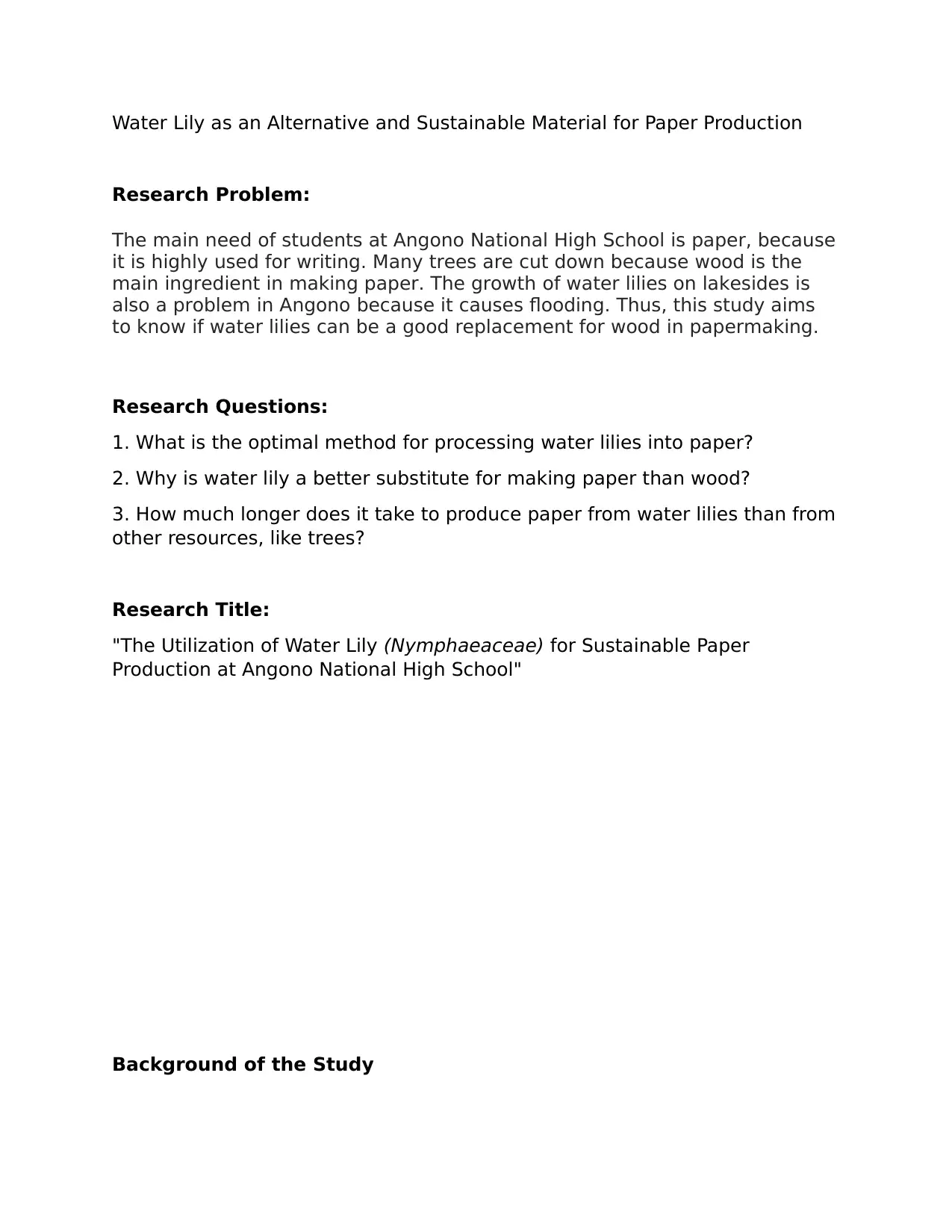
Water Lily as an Alternative and Sustainable Material for Paper Production
Research Problem:
The main need of students at Angono National High School is paper, because
it is highly used for writing. Many trees are cut down because wood is the
main ingredient in making paper. The growth of water lilies on lakesides is
also a problem in Angono because it causes flooding. Thus, this study aims
to know if water lilies can be a good replacement for wood in papermaking.
Research Questions:
1. What is the optimal method for processing water lilies into paper?
2. Why is water lily a better substitute for making paper than wood?
3. How much longer does it take to produce paper from water lilies than from
other resources, like trees?
Research Title:
"The Utilization of Water Lily (Nymphaeaceae) for Sustainable Paper
Production at Angono National High School"
Background of the Study
Research Problem:
The main need of students at Angono National High School is paper, because
it is highly used for writing. Many trees are cut down because wood is the
main ingredient in making paper. The growth of water lilies on lakesides is
also a problem in Angono because it causes flooding. Thus, this study aims
to know if water lilies can be a good replacement for wood in papermaking.
Research Questions:
1. What is the optimal method for processing water lilies into paper?
2. Why is water lily a better substitute for making paper than wood?
3. How much longer does it take to produce paper from water lilies than from
other resources, like trees?
Research Title:
"The Utilization of Water Lily (Nymphaeaceae) for Sustainable Paper
Production at Angono National High School"
Background of the Study
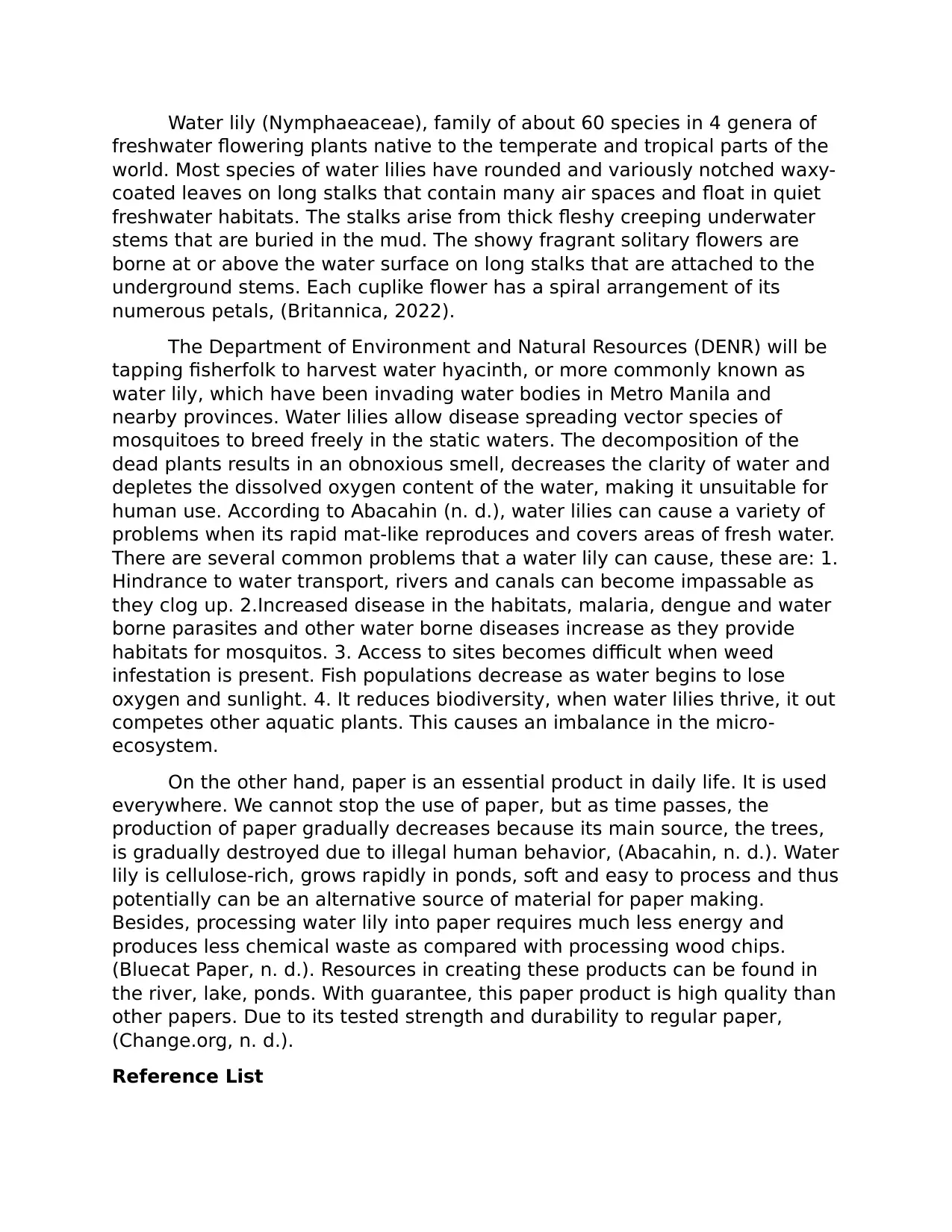
Water lily (Nymphaeaceae), family of about 60 species in 4 genera of
freshwater flowering plants native to the temperate and tropical parts of the
world. Most species of water lilies have rounded and variously notched waxy-
coated leaves on long stalks that contain many air spaces and float in quiet
freshwater habitats. The stalks arise from thick fleshy creeping underwater
stems that are buried in the mud. The showy fragrant solitary flowers are
borne at or above the water surface on long stalks that are attached to the
underground stems. Each cuplike flower has a spiral arrangement of its
numerous petals, (Britannica, 2022).
The Department of Environment and Natural Resources (DENR) will be
tapping fisherfolk to harvest water hyacinth, or more commonly known as
water lily, which have been invading water bodies in Metro Manila and
nearby provinces. Water lilies allow disease spreading vector species of
mosquitoes to breed freely in the static waters. The decomposition of the
dead plants results in an obnoxious smell, decreases the clarity of water and
depletes the dissolved oxygen content of the water, making it unsuitable for
human use. According to Abacahin (n. d.), water lilies can cause a variety of
problems when its rapid mat-like reproduces and covers areas of fresh water.
There are several common problems that a water lily can cause, these are: 1.
Hindrance to water transport, rivers and canals can become impassable as
they clog up. 2.Increased disease in the habitats, malaria, dengue and water
borne parasites and other water borne diseases increase as they provide
habitats for mosquitos. 3. Access to sites becomes difficult when weed
infestation is present. Fish populations decrease as water begins to lose
oxygen and sunlight. 4. It reduces biodiversity, when water lilies thrive, it out
competes other aquatic plants. This causes an imbalance in the micro-
ecosystem.
On the other hand, paper is an essential product in daily life. It is used
everywhere. We cannot stop the use of paper, but as time passes, the
production of paper gradually decreases because its main source, the trees,
is gradually destroyed due to illegal human behavior, (Abacahin, n. d.). Water
lily is cellulose-rich, grows rapidly in ponds, soft and easy to process and thus
potentially can be an alternative source of material for paper making.
Besides, processing water lily into paper requires much less energy and
produces less chemical waste as compared with processing wood chips.
(Bluecat Paper, n. d.). Resources in creating these products can be found in
the river, lake, ponds. With guarantee, this paper product is high quality than
other papers. Due to its tested strength and durability to regular paper,
(Change.org, n. d.).
Reference List
freshwater flowering plants native to the temperate and tropical parts of the
world. Most species of water lilies have rounded and variously notched waxy-
coated leaves on long stalks that contain many air spaces and float in quiet
freshwater habitats. The stalks arise from thick fleshy creeping underwater
stems that are buried in the mud. The showy fragrant solitary flowers are
borne at or above the water surface on long stalks that are attached to the
underground stems. Each cuplike flower has a spiral arrangement of its
numerous petals, (Britannica, 2022).
The Department of Environment and Natural Resources (DENR) will be
tapping fisherfolk to harvest water hyacinth, or more commonly known as
water lily, which have been invading water bodies in Metro Manila and
nearby provinces. Water lilies allow disease spreading vector species of
mosquitoes to breed freely in the static waters. The decomposition of the
dead plants results in an obnoxious smell, decreases the clarity of water and
depletes the dissolved oxygen content of the water, making it unsuitable for
human use. According to Abacahin (n. d.), water lilies can cause a variety of
problems when its rapid mat-like reproduces and covers areas of fresh water.
There are several common problems that a water lily can cause, these are: 1.
Hindrance to water transport, rivers and canals can become impassable as
they clog up. 2.Increased disease in the habitats, malaria, dengue and water
borne parasites and other water borne diseases increase as they provide
habitats for mosquitos. 3. Access to sites becomes difficult when weed
infestation is present. Fish populations decrease as water begins to lose
oxygen and sunlight. 4. It reduces biodiversity, when water lilies thrive, it out
competes other aquatic plants. This causes an imbalance in the micro-
ecosystem.
On the other hand, paper is an essential product in daily life. It is used
everywhere. We cannot stop the use of paper, but as time passes, the
production of paper gradually decreases because its main source, the trees,
is gradually destroyed due to illegal human behavior, (Abacahin, n. d.). Water
lily is cellulose-rich, grows rapidly in ponds, soft and easy to process and thus
potentially can be an alternative source of material for paper making.
Besides, processing water lily into paper requires much less energy and
produces less chemical waste as compared with processing wood chips.
(Bluecat Paper, n. d.). Resources in creating these products can be found in
the river, lake, ponds. With guarantee, this paper product is high quality than
other papers. Due to its tested strength and durability to regular paper,
(Change.org, n. d.).
Reference List
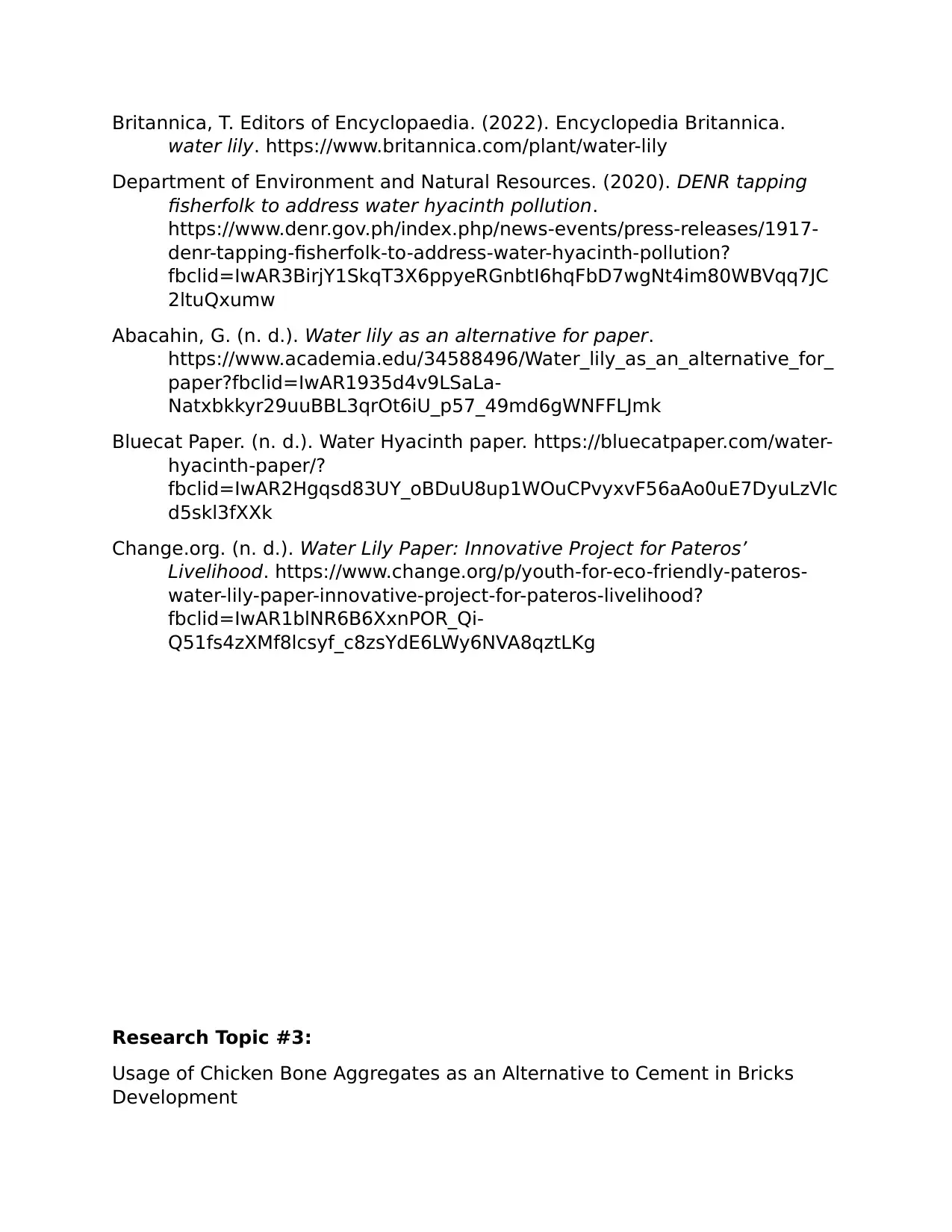
Britannica, T. Editors of Encyclopaedia. (2022). Encyclopedia Britannica.
water lily. https://www.britannica.com/plant/water-lily
Department of Environment and Natural Resources. (2020). DENR tapping
fisherfolk to address water hyacinth pollution.
https://www.denr.gov.ph/index.php/news-events/press-releases/1917-
denr-tapping-fisherfolk-to-address-water-hyacinth-pollution?
fbclid=IwAR3BirjY1SkqT3X6ppyeRGnbtI6hqFbD7wgNt4im80WBVqq7JC
2ltuQxumw
Abacahin, G. (n. d.). Water lily as an alternative for paper.
https://www.academia.edu/34588496/Water_lily_as_an_alternative_for_
paper?fbclid=IwAR1935d4v9LSaLa-
Natxbkkyr29uuBBL3qrOt6iU_p57_49md6gWNFFLJmk
Bluecat Paper. (n. d.). Water Hyacinth paper. https://bluecatpaper.com/water-
hyacinth-paper/?
fbclid=IwAR2Hgqsd83UY_oBDuU8up1WOuCPvyxvF56aAo0uE7DyuLzVlc
d5skl3fXXk
Change.org. (n. d.). Water Lily Paper: Innovative Project for Pateros’
Livelihood. https://www.change.org/p/youth-for-eco-friendly-pateros-
water-lily-paper-innovative-project-for-pateros-livelihood?
fbclid=IwAR1blNR6B6XxnPOR_Qi-
Q51fs4zXMf8lcsyf_c8zsYdE6LWy6NVA8qztLKg
Research Topic #3:
Usage of Chicken Bone Aggregates as an Alternative to Cement in Bricks
Development
water lily. https://www.britannica.com/plant/water-lily
Department of Environment and Natural Resources. (2020). DENR tapping
fisherfolk to address water hyacinth pollution.
https://www.denr.gov.ph/index.php/news-events/press-releases/1917-
denr-tapping-fisherfolk-to-address-water-hyacinth-pollution?
fbclid=IwAR3BirjY1SkqT3X6ppyeRGnbtI6hqFbD7wgNt4im80WBVqq7JC
2ltuQxumw
Abacahin, G. (n. d.). Water lily as an alternative for paper.
https://www.academia.edu/34588496/Water_lily_as_an_alternative_for_
paper?fbclid=IwAR1935d4v9LSaLa-
Natxbkkyr29uuBBL3qrOt6iU_p57_49md6gWNFFLJmk
Bluecat Paper. (n. d.). Water Hyacinth paper. https://bluecatpaper.com/water-
hyacinth-paper/?
fbclid=IwAR2Hgqsd83UY_oBDuU8up1WOuCPvyxvF56aAo0uE7DyuLzVlc
d5skl3fXXk
Change.org. (n. d.). Water Lily Paper: Innovative Project for Pateros’
Livelihood. https://www.change.org/p/youth-for-eco-friendly-pateros-
water-lily-paper-innovative-project-for-pateros-livelihood?
fbclid=IwAR1blNR6B6XxnPOR_Qi-
Q51fs4zXMf8lcsyf_c8zsYdE6LWy6NVA8qztLKg
Research Topic #3:
Usage of Chicken Bone Aggregates as an Alternative to Cement in Bricks
Development
Paraphrase This Document
Need a fresh take? Get an instant paraphrase of this document with our AI Paraphraser
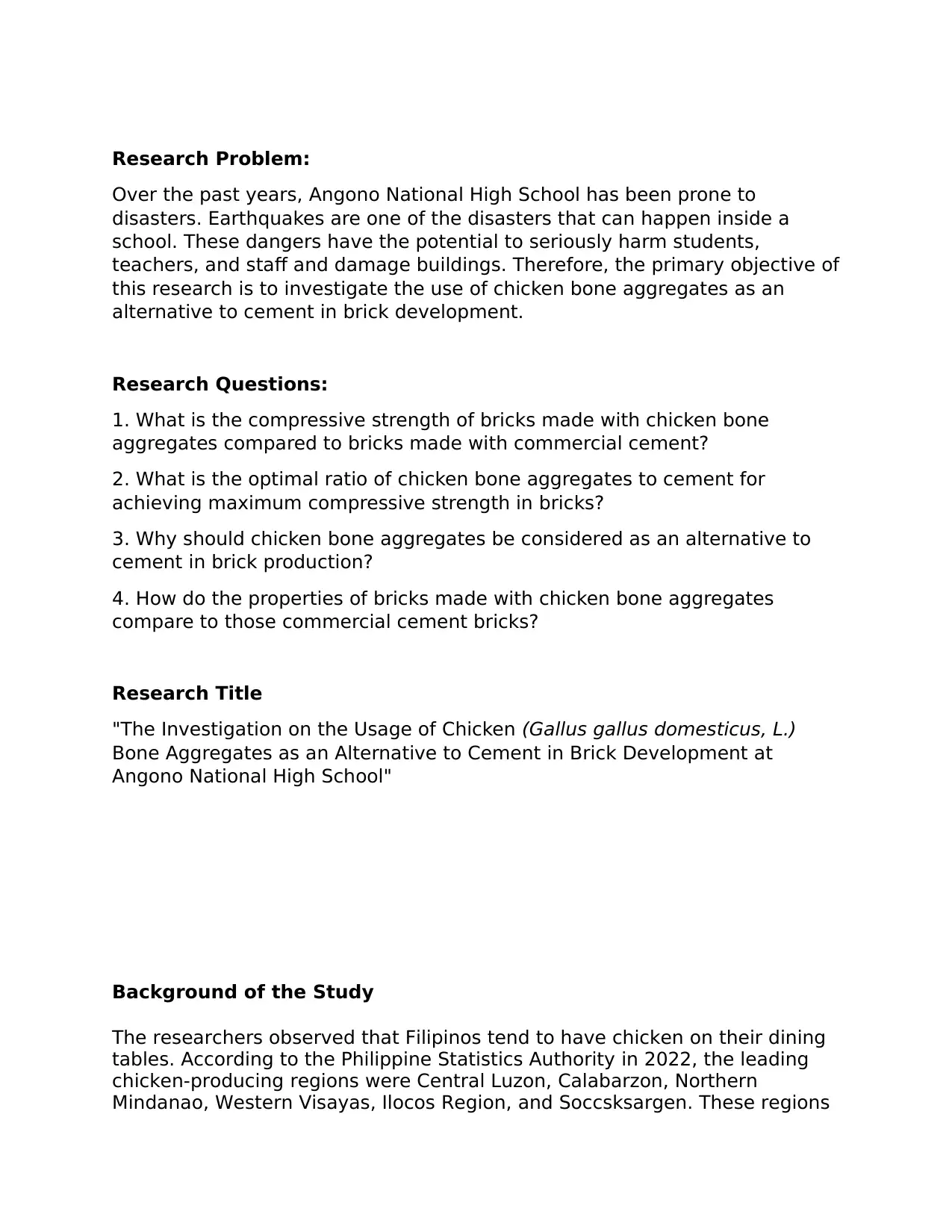
Research Problem:
Over the past years, Angono National High School has been prone to
disasters. Earthquakes are one of the disasters that can happen inside a
school. These dangers have the potential to seriously harm students,
teachers, and staff and damage buildings. Therefore, the primary objective of
this research is to investigate the use of chicken bone aggregates as an
alternative to cement in brick development.
Research Questions:
1. What is the compressive strength of bricks made with chicken bone
aggregates compared to bricks made with commercial cement?
2. What is the optimal ratio of chicken bone aggregates to cement for
achieving maximum compressive strength in bricks?
3. Why should chicken bone aggregates be considered as an alternative to
cement in brick production?
4. How do the properties of bricks made with chicken bone aggregates
compare to those commercial cement bricks?
Research Title
"The Investigation on the Usage of Chicken (Gallus gallus domesticus, L.)
Bone Aggregates as an Alternative to Cement in Brick Development at
Angono National High School"
Background of the Study
The researchers observed that Filipinos tend to have chicken on their dining
tables. According to the Philippine Statistics Authority in 2022, the leading
chicken-producing regions were Central Luzon, Calabarzon, Northern
Mindanao, Western Visayas, Ilocos Region, and Soccsksargen. These regions
Over the past years, Angono National High School has been prone to
disasters. Earthquakes are one of the disasters that can happen inside a
school. These dangers have the potential to seriously harm students,
teachers, and staff and damage buildings. Therefore, the primary objective of
this research is to investigate the use of chicken bone aggregates as an
alternative to cement in brick development.
Research Questions:
1. What is the compressive strength of bricks made with chicken bone
aggregates compared to bricks made with commercial cement?
2. What is the optimal ratio of chicken bone aggregates to cement for
achieving maximum compressive strength in bricks?
3. Why should chicken bone aggregates be considered as an alternative to
cement in brick production?
4. How do the properties of bricks made with chicken bone aggregates
compare to those commercial cement bricks?
Research Title
"The Investigation on the Usage of Chicken (Gallus gallus domesticus, L.)
Bone Aggregates as an Alternative to Cement in Brick Development at
Angono National High School"
Background of the Study
The researchers observed that Filipinos tend to have chicken on their dining
tables. According to the Philippine Statistics Authority in 2022, the leading
chicken-producing regions were Central Luzon, Calabarzon, Northern
Mindanao, Western Visayas, Ilocos Region, and Soccsksargen. These regions
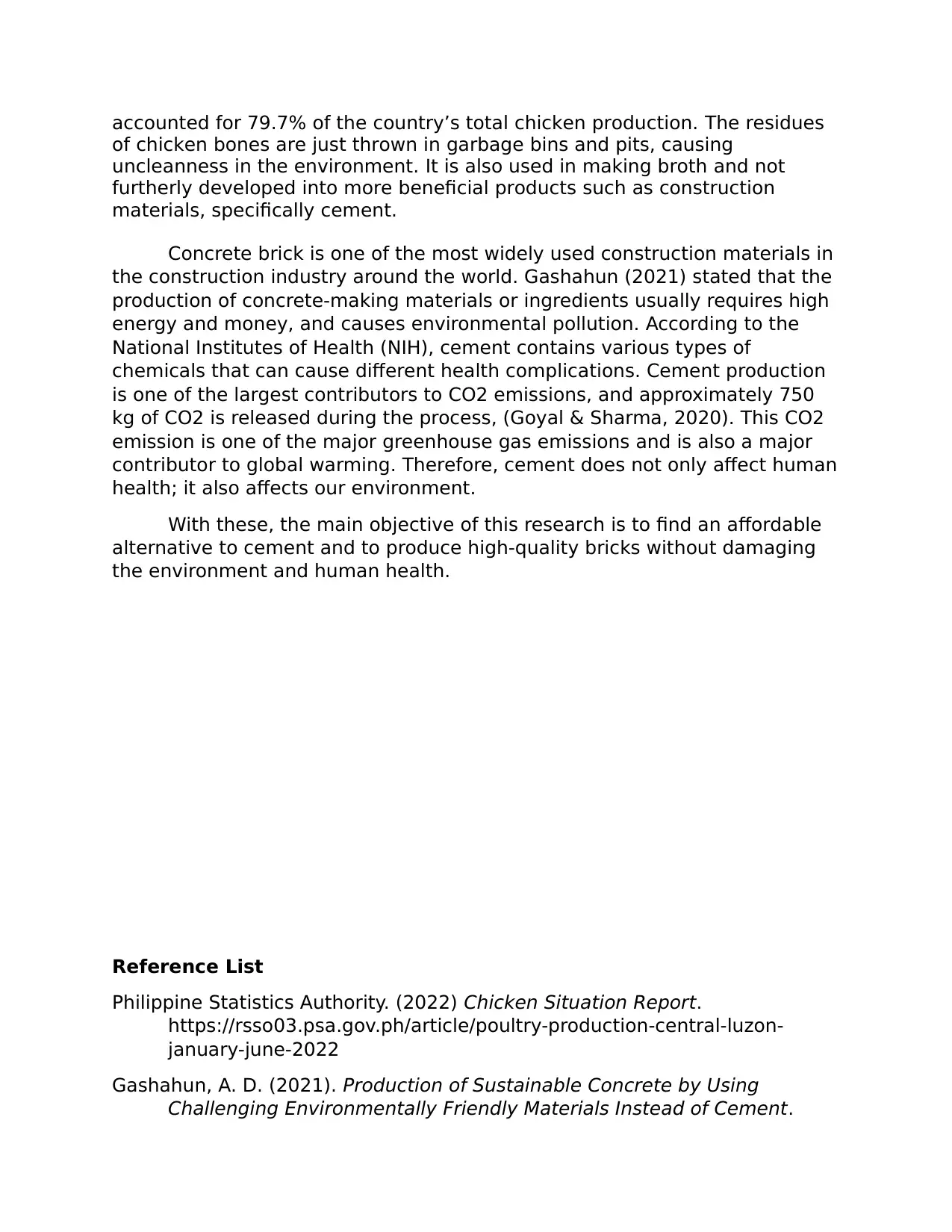
accounted for 79.7% of the country’s total chicken production. The residues
of chicken bones are just thrown in garbage bins and pits, causing
uncleanness in the environment. It is also used in making broth and not
furtherly developed into more beneficial products such as construction
materials, specifically cement.
Concrete brick is one of the most widely used construction materials in
the construction industry around the world. Gashahun (2021) stated that the
production of concrete-making materials or ingredients usually requires high
energy and money, and causes environmental pollution. According to the
National Institutes of Health (NIH), cement contains various types of
chemicals that can cause different health complications. Cement production
is one of the largest contributors to CO2 emissions, and approximately 750
kg of CO2 is released during the process, (Goyal & Sharma, 2020). This CO2
emission is one of the major greenhouse gas emissions and is also a major
contributor to global warming. Therefore, cement does not only affect human
health; it also affects our environment.
With these, the main objective of this research is to find an affordable
alternative to cement and to produce high-quality bricks without damaging
the environment and human health.
Reference List
Philippine Statistics Authority. (2022) Chicken Situation Report.
https://rsso03.psa.gov.ph/article/poultry-production-central-luzon-
january-june-2022
Gashahun, A. D. (2021). Production of Sustainable Concrete by Using
Challenging Environmentally Friendly Materials Instead of Cement.
of chicken bones are just thrown in garbage bins and pits, causing
uncleanness in the environment. It is also used in making broth and not
furtherly developed into more beneficial products such as construction
materials, specifically cement.
Concrete brick is one of the most widely used construction materials in
the construction industry around the world. Gashahun (2021) stated that the
production of concrete-making materials or ingredients usually requires high
energy and money, and causes environmental pollution. According to the
National Institutes of Health (NIH), cement contains various types of
chemicals that can cause different health complications. Cement production
is one of the largest contributors to CO2 emissions, and approximately 750
kg of CO2 is released during the process, (Goyal & Sharma, 2020). This CO2
emission is one of the major greenhouse gas emissions and is also a major
contributor to global warming. Therefore, cement does not only affect human
health; it also affects our environment.
With these, the main objective of this research is to find an affordable
alternative to cement and to produce high-quality bricks without damaging
the environment and human health.
Reference List
Philippine Statistics Authority. (2022) Chicken Situation Report.
https://rsso03.psa.gov.ph/article/poultry-production-central-luzon-
january-june-2022
Gashahun, A. D. (2021). Production of Sustainable Concrete by Using
Challenging Environmentally Friendly Materials Instead of Cement.
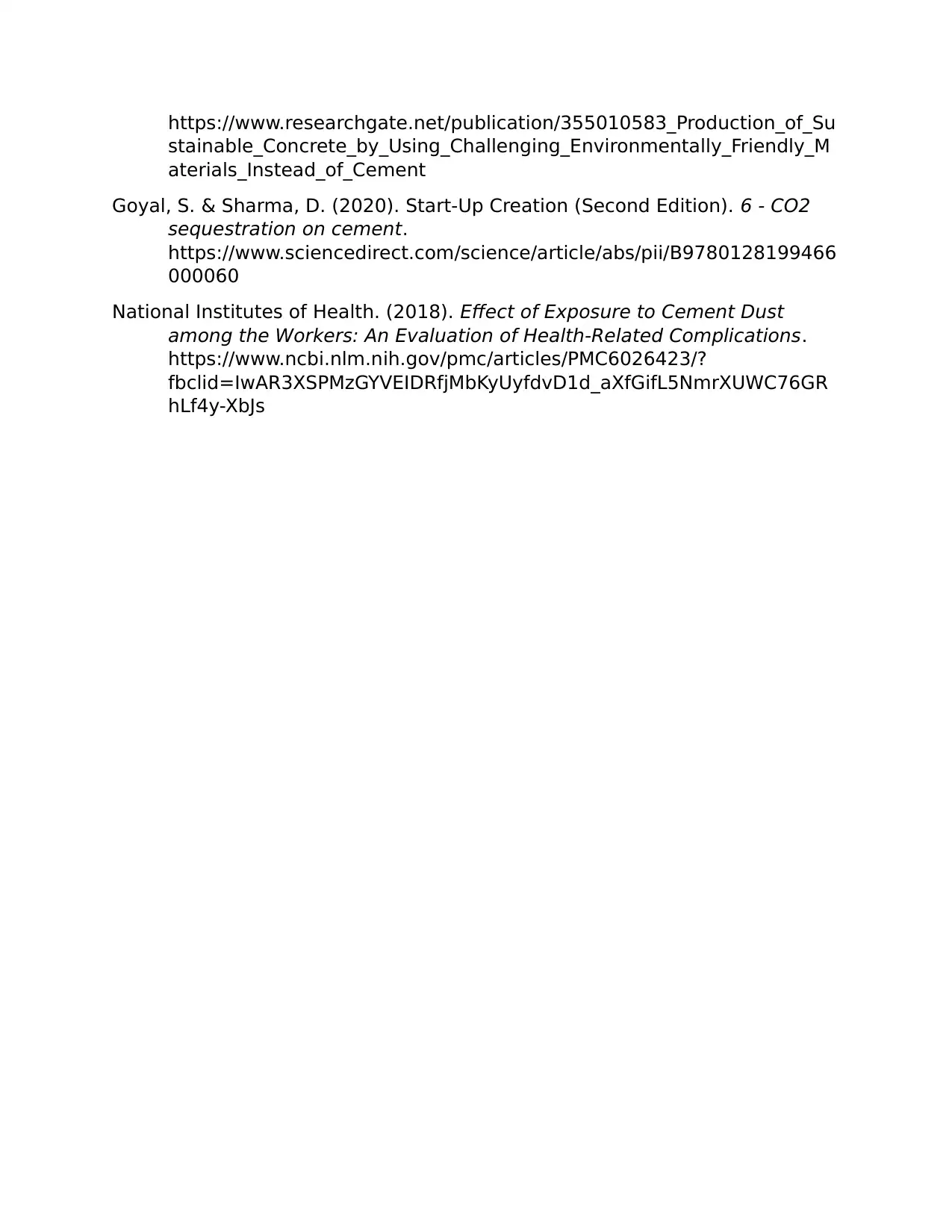
https://www.researchgate.net/publication/355010583_Production_of_Su
stainable_Concrete_by_Using_Challenging_Environmentally_Friendly_M
aterials_Instead_of_Cement
Goyal, S. & Sharma, D. (2020). Start-Up Creation (Second Edition). 6 - CO2
sequestration on cement.
https://www.sciencedirect.com/science/article/abs/pii/B9780128199466
000060
National Institutes of Health. (2018). Effect of Exposure to Cement Dust
among the Workers: An Evaluation of Health-Related Complications.
https://www.ncbi.nlm.nih.gov/pmc/articles/PMC6026423/?
fbclid=IwAR3XSPMzGYVEIDRfjMbKyUyfdvD1d_aXfGifL5NmrXUWC76GR
hLf4y-XbJs
stainable_Concrete_by_Using_Challenging_Environmentally_Friendly_M
aterials_Instead_of_Cement
Goyal, S. & Sharma, D. (2020). Start-Up Creation (Second Edition). 6 - CO2
sequestration on cement.
https://www.sciencedirect.com/science/article/abs/pii/B9780128199466
000060
National Institutes of Health. (2018). Effect of Exposure to Cement Dust
among the Workers: An Evaluation of Health-Related Complications.
https://www.ncbi.nlm.nih.gov/pmc/articles/PMC6026423/?
fbclid=IwAR3XSPMzGYVEIDRfjMbKyUyfdvD1d_aXfGifL5NmrXUWC76GR
hLf4y-XbJs
1 out of 10
Your All-in-One AI-Powered Toolkit for Academic Success.
+13062052269
info@desklib.com
Available 24*7 on WhatsApp / Email
![[object Object]](/_next/static/media/star-bottom.7253800d.svg)
Unlock your academic potential
© 2024 | Zucol Services PVT LTD | All rights reserved.